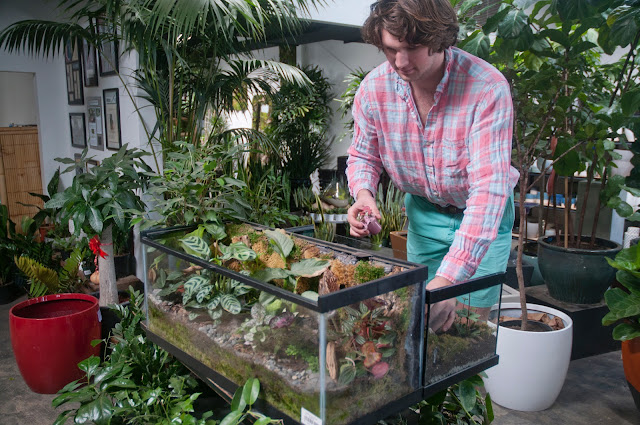
Exotic Plants hosts hands-on workshop to build your own pet-friendly habitat

|
| Exotic Plants shop manager Maxon Fackert adds more plants to a vivarium. (Photo courtesy N&R Publications) |
What’s the difference between a terrarium and a vivarium? Terrariums are designed to raise plants; vivariums focus on animals and their habitat – which happens to be filled with plants.
Pet reptiles and amphibians love these enclosed jungles – and so do their people. Here’s your chance to make your own vivarium – and help your pet reptile or amphibian friends feel right at home.
Exotic Plants is hosting a “Build Your Own Vivarium” workshop at 5:30 p.m. Saturday, March 26.
This hands-on workshop will help you make an animal-friendly habitat with all the supplies you need. Participants may bring in their own tank or use a 10-gallon starter tank.
Maxon Fackert, Exotic Plants shop manager, will instruct this interesting workshop and offer his advice for success. Fackert keeps frogs in his own vivarium at home and also watches over the shop’s pet albino boa in its vivarium.
Seating is limited, so it's best to register now. Prices will vary, depending on tank and plant needs. Besides the tank, workshop fee also includes materials, plants and instruction.
Exotic Plants is located at 1525 Fulton Avenue, Sacramento. To sign up for the workshop, call 916-922-4769.
The store's website: www.exoticplantsltd.com .
Comments
0 comments have been posted.Sacramento Digs Gardening to your inbox.
Sites We Like
Garden Checklist for week of July 21
Your garden needs you!
* Keep your vegetable garden watered, mulched and weeded. Water before 8 a.m. to reduce the chance of fungal infection and to conserve moisture.
* Feed vegetable plants bone meal, rock phosphate or other fertilizers high in phosphate to stimulate more blooms and fruiting. (But wait until daily high temperatures drop out of the 100s.)
* Don’t let tomatoes wilt or dry out completely. Give tomatoes a deep watering two to three times a week.
* Harvest vegetables promptly to encourage plants to produce more. Squash especially tends to grow rapidly in hot weather. Keep an eye on zucchini.
* Pinch back chrysanthemums for bushy plants and more flowers in September.
* Remove spent flowers from roses, daylilies and other bloomers as they finish flowering.
* Pinch off blooms from basil so the plant will grow more leaves.
* Cut back lavender after flowering to promote a second bloom.
* It's not too late to add a splash of color. Plant petunias, snapdragons, zinnias and marigolds.
* From seed, plant corn, pumpkins, radishes, winter squash and sunflowers.